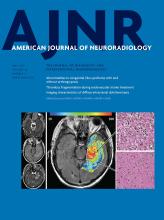In their recent article, Yuan et al1 stated that they “highlight the merits and limitations of various imaging techniques for identifying carotid plaque ulceration.” It is curious, therefore, that they made no mention of 3D sonography (3DUS). Although ulceration seen on angiography predicted risk in the North American Symptomatic Carotid Endarterectomy Trial,2 it was clear that imaging of the lumen by angiography was not a reliable way to assess ulceration.3
Schminke et al4 reported that 3DUS was a better way to image ulceration than 2D sonography. In 2011, we reported that the number of carotid ulcers (Fig 1) was as strong a predictor of risk among patients with asymptomatic carotid stenosis; patients with ≥3 ulcers in either carotid artery had a risk equivalent to that of patients with microemboli on transcranial Doppler sonography.5
Number of carotid ulcers. The carotid artery can be examined in any axis for detection of ulcers in atherosclerotic plaques. White arrows show ulcers. Reproduced with permission of Wolters Kluwer from Madani et al.5
In 2104, we reported that ulcer volume predicted cardiovascular risk among patients attending cardiovascular prevention clinics (Fig 2).6 It is likely that the best way to image and quantify carotid ulceration is with 3DUS.
Measurement of ulcer volume and ulcer depth. Contours of ulcers were traced, and the depth of ulcers was measured in cross-sectional views. Each section had a thickness of 1 mm; ulcer volume was computed from the sum of the volumes of all sections in which ulceration was traced. Reproduced with permission of Wolters Kluwer from Kuk et al.6
Footnotes
Disclosures: J. David Spence—UNRELATED: Other: Dr Spence is an officer of Vascularis Inc.
REFERENCES
- © 2017 by American Journal of Neuroradiology














